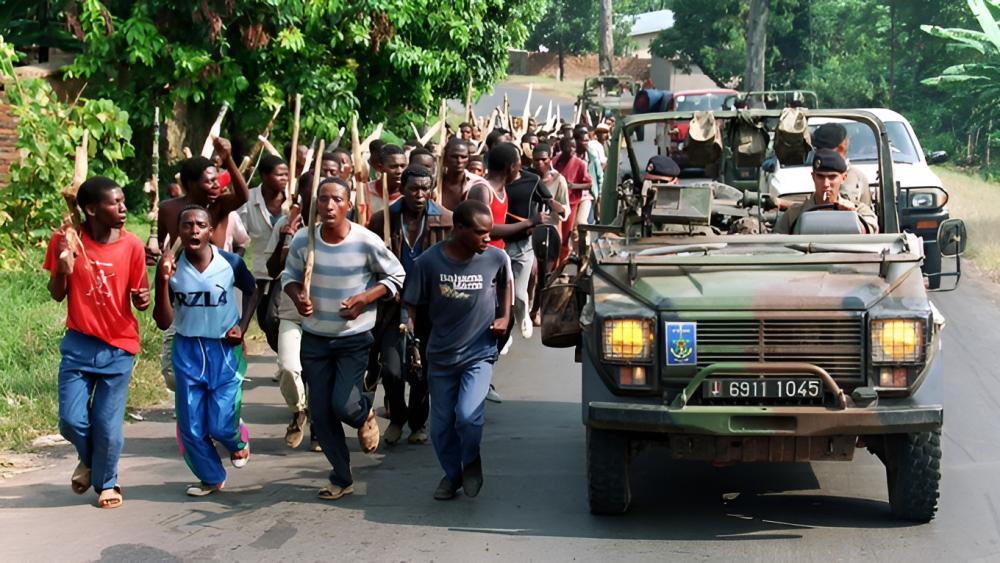Africa-Press – Rwanda. On April 18, 1994, the Interahamwe militia continued to hunt down the Tutsi and killed them using various weapons, including guns, grenades, wooden clubs, and machetes.
On that day, killings took place in various parts of the country. In Kamembe, for example, 60 Tutsi who had taken refuge at the commune’s offices were killed after a man who had hidden them, Casimir Gatera, a commune staff member, was intimidated by the mayor and surrendered them to the murderers.
In Simbi Sector, in Butare, more than 40,000 Tutsi were killed when soldiers, policemen, and Interahamwe, attacked them with grenades, stones, and machetes, while in Rwamagana, at Sovu school, more than 15,000 Tutsi were killed by municipal police and Interahamwe mainly using guns.
In many more places, killings took place, the most horrible of which was the massacre of more than 50,000 Tutsi in Kabuya swamp in Rwamagana.
In Kamonyi, terrible killings also took place.
In Nyarusange village of Karengera cell, Musambira sector, Pio Ntahobari, the head priest of a local church, together with a teacher called Rwakayigamba and a church secretary called Nyagahene denied the Tutsi entrance into the church saying that they would destroy it.
Having been denied refuge in the church, the Tutsi camped at a market opposite the church but they were chased away from there too and told that their God was at Kabgayi and it is where they should go.
The displaced Tutsi headed to Kibuza where they were attacked by a group of killers but managed to escape before they met another group at Gaperi, which was harder to escape. There the Interahamwe killed men and boys only.
Some survivors carried on running to Musambira Parish and entered the church there.
The next morning, however, a truck full of soldiers arrived at the church and held a meeting with Interahamwe that had arrived from Kivuye (in Burera).
After the meeting, the priest of the church told the Tutsi hiding there to leave, especially the ones who had arrived last.
As they left, the soldiers started shooting them to death one by one.
In Rusizi, at Nkaka Parish, many Tutsi were killed, having fled to the place from killings that had started in Gitwa and Murambi.
They came to the parish because the mayor of Kamembe Commune Jean Napoleon Mubiligi had told them that they will be protected there.
On April 8, 1994, top officials in the genocidal government including then President Theodore Sindikubwabo visited some places in rural Rwanda to plan further killings and incite the masses as the Genocide against the Tutsi gained momentum.
On that day, Sindikubwabo visited the former Gikongoro Prefecture (current Nyamagabe and Nyaruguru) and held a meeting with local leaders about arranging killings in areas like Kaduha, Murambi, and Cyanika.
Édouard Karemera, the then Minister of Institutional Relations, visited the former Gitarama Prefecture (current Muhanga and Ruhango) to mobilise people there to start genocide.
The Tutsi continued to die across the country.
For instance, at Gatwaro stadium in the former Kibuye Prefecture (current Karongi), many Tutsi were killed, having been taken there by the local authorities, who had lied to them that they would be protected.
The victims of the Gatwaro stadium massacre had survived earlier attacks at Kibuye Church, Home Saint Jean, and Mubuga Church.
As they took refuge at Gatwaro, they were joined by their counterparts from Mabanza Commune.
Before upon entering the stadium, all their belongings including sticks had to be taken away.
They stayed in the stadium for some days before they were murdered. During that time, water pipes supplying the stadium were cut and the Tutsi inside got very ill due to poor sanitation.
Some of them who tried to seek medication at Kibuye hospital were killed on the way or forced to return to the stadium without getting any help.
For More News And Analysis About Rwanda Follow Africa-Press






